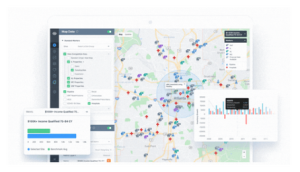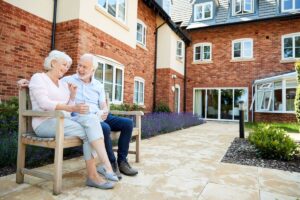Imagine that you’re an elderly diabetic patient in your early 80s. Today you’re having a routine checkup with your doctor just to make sure everything is in tip-top shape. But instead of going to a doctor’s office, you simply log on to your computer for a brief consultation.
With just a few clicks, your doctor uploads all the data from your wearable device so they can take a look at your blood glucose levels and vital signs. Your appointment is over in a matter of minutes. You didn’t have to find transportation to the doctor’s office, nor did you have to schedule your entire day around the appointment. In fact, all you had to do was open your computer for a routine checkup.
This may sound like a futuristic scene out of a sci-fi movie, but cloud-based technology has made this a present-day reality for seniors.
The senior care industry has historically been slow to adopt technological advancements such as cloud solutions for a number of reasons, not the least of which concerns data security and HIPAA compliance. To make matters more complicated, a high volume of patient information would need to be converted to the cloud, and we’d be asking significant behavioral changes of a generation not particularly well-known for its technological proficiency.
But an increased fervor in cloud adoption couldn’t have come at a better time. With COVID-19 affecting seniors more than any other age group, telehealth has become a prudent alternative for certain in-person doctor visits. Medicare recently expanded their coverage for telemedicine to ensure that seniors are still getting the medical attention they need, while also keeping them safe from avoidable exposure.
Beyond the current pandemic, ten thousand people are also set to turn 65 every day for the next 20 years in the United States alone. Longer lifespans mean an increased need for medical care. One in five boomers have already been diagnosed with diabetes. Over half of their generation has been prescribed pills to lessen the effects of hypertension, which is all the more important because 40 percent of boomers are considered obese. And this list is just the tip of the health-issues iceberg. It’s projected that by 2030, 60 percent of the generation will be managing more than one chronic health condition.
Caring for an increasingly aging population will continue to put a strain on senior care unless we embrace new solutions that account for these demographic shifts. Thankfully, that shift is well underway.
Technology isn’t just a young person’s game anymore. An increasing number of seniors now own smartphones and various smart devices. Over 17 percent have even started using wearable devices in their everyday lives. Younger generations may covet wearables to track their fitness and weight loss journeys, but the advantages extend far beyond counting calories.
Smart devices can now measure a person’s heart rate, blood pressure, body temperature, and oxygen levels. One new gadget can even analyze blood sugar levels without an incision. Others can detect falls in real-time and will send an alert to a call center that will immediately dispatch emergency services to the person’s home.
Wearables give seniors peace of mind knowing they’re protected if their health would take an abrupt turn for the worse. Gone are the days of countless tests to pinpoint what’s causing the health issue, and weeks of having to wait for those test results to come back. With wearables, a physician or nurse can remotely monitor a patient’s vitals from afar, alleviating the strain on the senior care system and minimizing unnecessary, routine appointments.
Many seniors worry that remote checkups won’t allow for the same quality of care, but the evidence indicates otherwise. A recent study shows that telemedicine results in 38 percent fewer hospital admissions, 31 percent fewer readmissions and over 60 percent of people spend fewer consecutive days in the hospital.
Remote monitoring can also help seniors take control of their own health on a more regular basis. Say someone suffers from a severe heart condition, for example. By monitoring their vitals, a patient’s wearable device can incentivize them to stay away from salty snacks that could have dire consequences. These technologies are so advanced they can even signal whether a heart palpitation is being caused by indigestion or is a sign of something more serious.
It’s common for seniors to live more sedentary lifestyles, especially those that struggle with physical ailments or other chronic health conditions. But we know that sedentary lifestyles worsen the majority of health issues, which is why an age and health-appropriate exercise regimen is so important for longevity and stamina. Just as wearables can monitor medical conditions, they can also keep seniors on track with their health and activity levels, providing a much-needed breath of independence.
While cloud technology’s advantages are significant, they are not without challenges. While the U.S. Department of Health & Human Services temporarily loosened HIPAA restrictions to allow greater access to telehealth during the COVID-19 outbreak, it is unclear to what extent that will remain so afterward. Similar uncertainties surround Medicare’s expanded telemedicine coverage.
Also of particular importance is ongoing staff education. In order to provide the best care to patients, nurses and physicians need access to updated policies, procedures, and resources that inform care and treatment options. Thankfully, the cloud also makes staff education easier, serving as a one-stop database for guidelines and changes in treatment, technology, and protocols.
Cloud technology allows healthcare facilities to achieve the holy grail of senior care: it’s cost-effective, it allows for operational efficiency, and it encourages better outcomes through patient independence. It is not a replacement for face-to-face care, but it does provide much-needed support to a heavily strained system. The level of care we provide to residents and patients only goes as far as the innovations we choose to enmesh within our operations. If we don’t take cloud technologies seriously, we only hurt those we claim to serve.
Published by

Originally published on McKnight’s Long-Term Care News on June 8th, 2020.






